Did you know that if you play one particular harmonica a lot, it might need to be replaced after 6 to 12 months?
If that’s true, then why is it also true that you could have another harmonica that remains in perfect condition for over 30 years? What’s the rub?
In this blog I’m going to share with you some simple strategies for maintaining the performance of your harmonica as well as a simple trick for sterilizing.
So, How Do You Get Your Harmonicas to Last a Long Time and Stay in Tune?
Here’s a quick overview:
- Reduce rust.
- Keep harmonicas free from particulates (lint, particles of food, any beverages other than water, etc…).
- Don’t blow too hard and don’t let others play your harmonicas. (Stressing the reeds will put the reeds out of tune.)
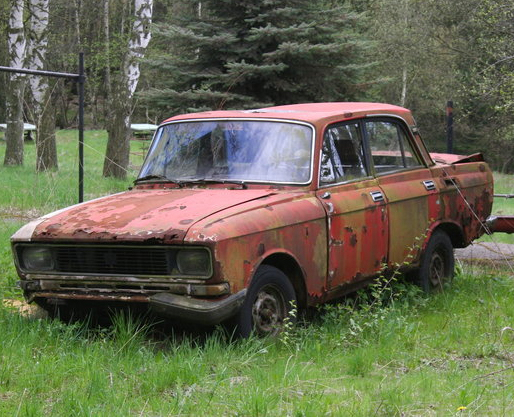
Why might one harmonica last only 6 months and why might one last over 30 years? To begin with, it might help if you think about a harmonica like you do a car. It has moving mechanical parts and the more mileage you rack up the quicker the harmonica will deteriorate.
And, just like a car, the moving mechanical parts of harmonicas (i.e. the reeds) will deteriorate more quickly if they:
- Rack up a lot of miles (by being played a lot).
- Rust.
- Are given dirty fuel (not played with a clean mouth).
- Are stressed by “putting the pedal to the metal” (i.e. playing too loud).
What Determines How Long a Harmonica Lasts?
- How much you play it.
- How hard (loud) you play it.
- The style of playing you’re doing (playing blues with mojo stresses the reeds more than playing pretty melodies).
- The model (stainless steel reeds last much longer, but beginners often find them stiff and hard to bend).
- How much moisture the harmonica is exposed to.
So, if you want a harmonica to last over 30 years, play it softly, play it very little, dry it immediately, and store it in a cool, dry and airtight container. Not very practical for most of us (unless we’re a collector).
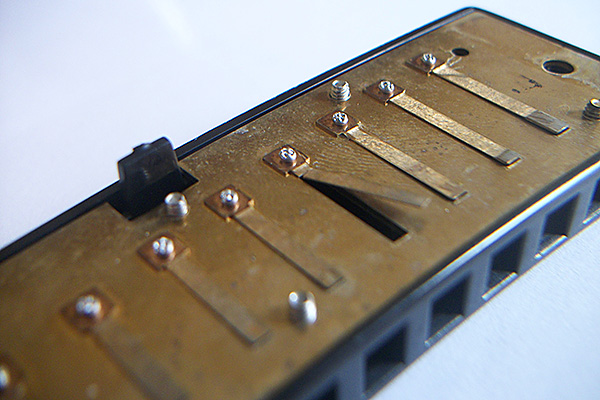
I admit I kind of set you up by implying that you could maintain a harmonica for 30 years. I did this because my students are regularly stunned to find out they need to periodically replace their harmonicas.
I was hoping to drive the point home that if you play one individual harmonica a lot, and you’re bending and playing the blues with some umph, then the reeds might only last 6 months before they need to be replaced. (I’ve had particular harmonicas that have lasted me several years but that’s usually because I don’t play them a lot. For example, I don’t play some of the flat keys as often as the natural keys.)
Furthermore, because replacing reeds on most models of harmonicas is more money- and time-intensive than replacing the entire harmonica, I generally just buy a new harmonica and I recommend my students do the same.
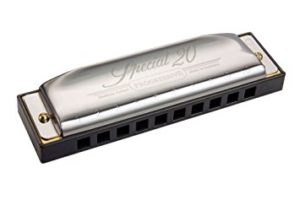
That said, if you’re handy and you like working with tools, you might enjoy replacing individual reeds or entire reed plates if you can get them. (Some harmonica models have replaceable reed plates and others don’t.)
You’ll find that the 4, 5 or 7 hole draw reeds will be most vulnerable to wearing out, especially if you play them with excessive air pressure down past the point of their available bending range. See point 7 down below for more on this.
7 Simple Strategies for Increasing Your Harmonica’s Life Expectancy
- Brush teeth and/or rinse your mouth with water before playing. Your mouth should always be clean before playing. Prevent food particles, coffee, tea, soda, beer or anything other than water (and the natural moisture from your lungs and mouth) to enter the harmonica.
- Don’t get drunk and play the harmonica with all your might. The point is, don’t play the harmonica with all your might. This will kill your harp fast.
- If you want to share, get an economical harmonica that’s just for loaning to others. Don’t let kids or anyone play your high performance harmonicas unless they understand that harmonicas are NOT to be played with maximum air-flow.
- Let your harmonica air-dry quickly after playing. Reduce oxidation (rust) by allowing your harmonica to dry quickly after playing (I like to keep my case open in a place with minimal dust).
- Slap out residual moisture after playing. This is another great strategy to reduce oxidation (watch video above for clarity).
- Transport harmonicas in a case. Protect your harmonica from coins, lint etc… If you want to keep a harmonica in your pocket and you don’t have a case then use a Ziplock bag.
- And, most importantly, learn to play with moderate air pressure (to decrease the stress on the reeds). You can learn to play with “massive blues mojo” while playing with moderate air pressure. (Be careful with 4, 5 and 7 draw bends as mentioned above because they can be more vulnerable to excessive air pressure.) In addition, if you learn to “throw the sound” into your cranial sinus cavities as a singer does, you’ll get plenty of volume. It may take some retraining, but you will find that you’ll be able to play with moderate air pressure and still get a gritty blues tone and have total control of your bends. This could be the most important adjustment you make to your technique but it will require a high level of awareness and proper training as we offer in Beginner to Boss and Breakthrough Blues. It will also help if you have a high quality professional harmonica. Click here to see my current #1 harmonica recommendations.
One of My Harmonica Notes Is Not Playing! Why!?
Most common reason for a reed to stop playing is from excess saliva (see my video above for more info on this).
Your Head Should Be Upright When You Play to Keep Saliva From Flowing Down Into the Harmonica.
Sometimes when students are reading music that’s on a desk, they let their head tilt downward. A simple remedy to this problem is to get a music stand.
I’ve learned to let moisture in my mouth pool under my tongue and then I swallow frequently to prevent saliva from getting into the harmonica.
What If Saliva Is Clogging a Reed? Remedies:
- Slap out the extra moisture into the palm of your hand.
- Rapidly go back and forth from the blow to the draw.
- Put the harmonica in a place it can dry quickly (e.g. near a fan).
Watch Out for Lint and Whiskers!
If removing the saliva doesn’t work, you might have to take apart your harmonica to see if anything has clogged the reeds (lint, hair, a whisker, etc). When removing any foreign substances from the harmonica that might be blocking the reeds, be careful not to move the reed off its center or it will buzz or malfunction.
What About Breaking in the Reeds When You First Buy a Harmonica?
There’s a theory that your harmonica will last longer and stay in tune if you break it in with gentle playing. In theory, soft playing encourages the crystals in the metal to align, which is “good” for the reeds.
I’m personally not concerned for a couple of reasons.
Firstly, if you learn to play with moderate air pressure as explained above, then this is much less of an issue.
Secondly, I’ve heard Winslow Yerxa (author of Harmonica for Dummies, and one of the most well-respected harmonica players and teachers on the planet) state that there are no published scientific studies to support the claim that the crystals in the metal align during a “break in period”. His mechanical engineer colleagues seem to agree and so do I for the moment — but I’m open to change my mind if someone can provide solid evidence for their claim.
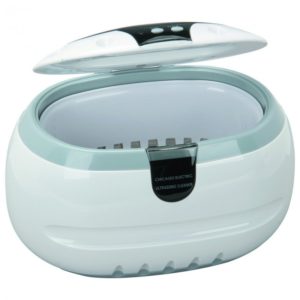
How to Sterilize a Harmonica?
Some pros use an ultrasonic cleaner with a disinfectant to sterilize their harmonicas (rinsing the reed plates under water after the ultrasonic bath). I am not averse to this strategy but, I have been satisfied with the use of a simple hydrogen peroxide bath I will explain below.
As long as you have a harmonica with a plastic comb, you can use a hydrogen peroxide bath for sterilizing the harmonica.
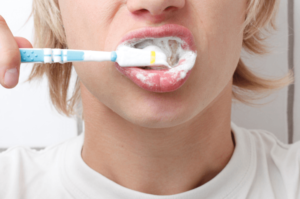
I’ve been using hydrogen peroxide on my harmonicas with plastic combs with 100 percent harm-free results for the last 25 years. I’m happy to share my ideas with you, but please bear in mind that I’m not an expert on the subject. I’ve tried cleaning with vinegar and alcohol but I’ve found the residue distasteful so I no longer use those substances.
As recommended above, if you brush your teeth and/or rinse your mouth with water before playing to make sure you mouth is clean, this will reduce the amount of contaminants that will settle on the harmonica and thus reduce the potential for bacterial growth (and the need for sterilization).
My only caveat to the use of hydrogen peroxide to sterilize your harmonica is to not do it too frequently because I’m unsure if frequent exposure will speed up the oxidation process.
I Personally Only Sterilize My Harmonicas Once Every 4 to 12 Months, When I Notice a Bitter Flavor in the Harmonica.
I’ve also directed the fan of my air-borne ozonator onto my harmonicas and that seems to work okay too.
How JP sterilizes his harmonicas:
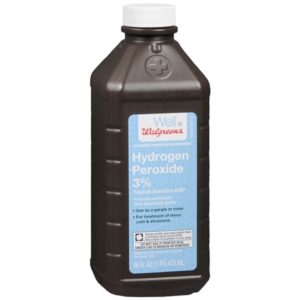
- Submerge harmonica in 3 percent hydrogen peroxide and soak for 5 to 10 minutes (please be aware that if your immune system is suppressed, this may not be a sufficient form of sterilization as some bacteria are resistant to 3 percent hydrogen peroxide).
- Rinse under tap water.
- Remove excess moisture by vigorously slapping out harmonica into a towel that is held in the palm of your hand.
- DRY QUICKLY: (Put the harmonica in front of a fan or in a warm place exposed to airflow that will allow it to dry as quickly as possible.
PLEASE NOTE: To play it safe, I’m going to advise against this technique if your harmonica has a bamboo or wood comb. There’s a pretty good chance you’ll be okay if you don’t soak the harmonica too long and you dry it immediately, but you’ll need to check with your harmonica manufacturer to be certain. The other option is to remove the reed plates and only place the reed plates into the hydrogen peroxide bath but this will require a bit more effort.
Say What? Run Water From the Faucet Through Your Harmonica?
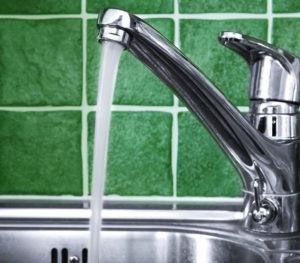
If I’m out at a gig or hanging out at a party and someone plays my harmonica without my permission, I simply run water from the faucet through the harmonica.
I admit it. Maybe I’m a bit too squeamish, but if someone has been ingesting beer, chips or soda, I definitely don’t want the sticky carbohydrates settling on the reeds.
Only When You’re in a Jam!

If you play harmonicas that use a plastic polymer comb, l see no problem with periodically blasting water from the faucet through the harmonica to clean it out, as long as you THOROUGHLY DRY the harmonica after water exposure. As mentioned above, you might not want to use this technique if you have a wood or bamboo comb.
I Tend to Lean Toward Harmonicas With Plastic Polymer Combs (like the hohner Special 20) for This Very Reason – They’re so Much Easier for Me to Clean!!!
Here’s an old audio recording that I made years ago that talks a bit more about harmonica maintenance (some of the info is redundant but there are some new ideas you might find interesting.)
I hope this article on harmonica maintenance was helpful and gives you ideas on how to maximize the life expectancy of your instruments. Please don’t take any of my ideas as gospel. I’m just a harmonica loving’ fool like everyone else.
I would love to hear your thoughts, criticisms and concerns in the comments below (feel free to share honestly as your ideas will help thousands of other readers).

Comments
Got something to say? Post a comment below.